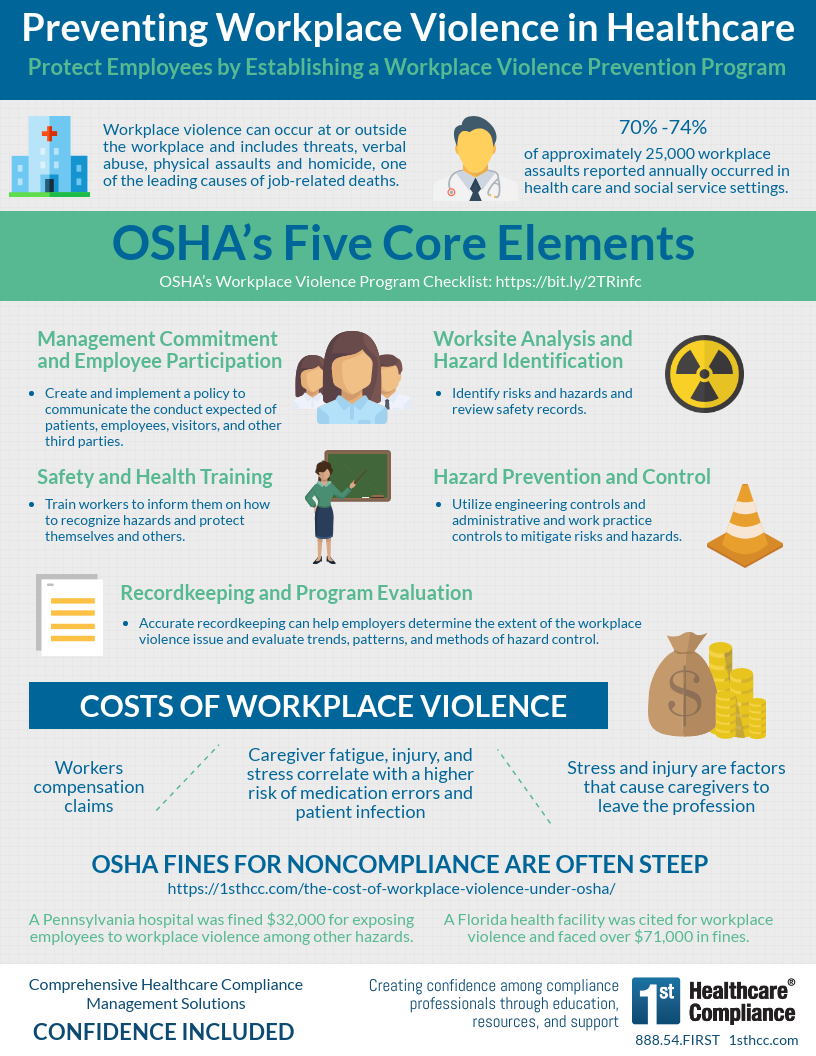Boosting Workplace Safety through California Workplace Violence Prevention
Boosting Workplace Safety through California Workplace Violence Prevention
Blog Article
Proven Strategies for Producing a Safe and Protect Work Environment Setting Via Violence Avoidance Steps
In the realm of workplace safety and security, the importance of carrying out effective physical violence prevention measures can not be overemphasized. As companies make every effort to cultivate environments that are not just effective yet additionally secure for all workers, the need for tested methods in physical violence prevention becomes critical. By checking out methods such as problem resolution training, emergency action planning, and fostering a society of security, workplaces can substantially improve their ability to mitigate prospective threats. These techniques not just address the instant issues bordering office physical violence yet additionally add to long-term approaches for producing a unified and secure workplace.

Comprehending Work Environment Physical Violence
To comprehend the dynamics of workplace physical violence, it is vital to evaluate the numerous forms and underlying elements adding to such occurrences. Workplace violence can manifest in different ways, consisting of verbal hazards, physical assaults, and also casualties. Understanding the types this physical violence can take is crucial in establishing reliable prevention strategies.
One usual type of workplace physical violence is physical aggressiveness, which involves any kind of physical get in touch with planned to cause injury. This can vary from striking and pushing to a lot more serious activities. Verbal hazards and harassment additionally comprise workplace physical violence, creating a hostile environment that can affect staff members' health and performance.
Additionally, workplace physical violence can be fueled by different underlying variables such as stress and anxiety, disputes, and organizational changes. Identifying these root causes makes it possible for companies to execute preventative steps that address the certain threats existing in their work environment.
Carrying Out Conflict Resolution Training
Comprehending the types and underlying aspects of workplace physical violence underscores the need for organizations to focus on carrying out dispute resolution training. Problem resolution training equips employees with the essential skills to recognize, address, and de-escalate potential conflicts prior to they escalate into fierce scenarios. By offering employees with effective interaction techniques, energetic paying attention methods, and analytical strategies, organizations can equip their labor force to navigate disagreements and disputes constructively.
Efficient dispute resolution training not only boosts employees' capacity to manage disputes but additionally fosters a society of respect, understanding, and partnership within the office. Through role-playing exercises, scenario evaluation, and practical workshops, employees can get hands-on experience in solving problems in harmony and skillfully. california workplace violence prevention. Problem resolution training can aid workers recognize very early caution indications of possible physical violence, enabling them to take aggressive steps to avoid unpredictable scenarios.
Incorporating problem resolution training as part of a company's thorough physical violence avoidance strategy shows a dedication to developing a risk-free and safe office setting where disputes are handled efficiently and physical violence is mitigated.
Establishing Emergency Situation Reaction Strategies
Developing extensive emergency action strategies is critical for making certain the safety and security and protection of workers in case of unforeseen incidents or emergencies within the work environment. These plans lay out the necessary actions to be taken during crises such as natural calamities, clinical emergency situations, fires, active shooter scenarios, or other threats to the wellness of team member.
To develop efficient emergency situation action plans, companies should conduct extensive threat assessments to determine prospective risks and susceptabilities details to their workplace. This information is then made use of to develop methods for evacuation procedures, interaction methods, assigned setting up points, and duties and obligations of staff members during emergencies. Regular training sessions and drills need to be carried out to acquaint workers with these plans and guarantee a swift and coordinated reaction when required.
Additionally, emergency situation feedback strategies must be frequently assessed and updated to line up with any type of changes in the workplace setting, personnel responsibilities, or prospective hazards. By purchasing the development of robust emergency situation reaction strategies, companies can better shield their staff members and decrease the impact of unexpected cases on the office.
Urging Reporting and Interaction
In fostering a society of safety and security and caution within the work environment, it is vital to highlight the relevance of encouraging reporting and interaction amongst employees. more information Open lines of communication produce an atmosphere where workers feel empowered to speak up concerning possible safety issues without anxiety of repercussions. Motivating coverage can help identify and deal with concerns before they escalate into severe cases.
To advertise coverage, companies ought to establish clear coverage procedures and channels, ensuring that workers understand just how and where to report safety issues or check these guys out cases. Educating sessions on identifying warning indicators of violence and the relevance of reporting should be provided on a regular basis. In addition, producing a non-punitive coverage system where employees can report concerns anonymously can better urge interaction.
Normal communication between monitoring and employees is additionally essential in keeping a risk-free workplace. Administration must proactively pay attention to worker feedback, address worries quickly, and provide updates on any kind of actions taken. By fostering a culture of open communication and encouraging coverage, companies can proactively stop workplace physical violence and create a much safer setting for all staff members.

Cultivating a Culture of Safety
To grow an office atmosphere that focuses on safety and instills a sense of collective duty, it is necessary to establish clear guidelines and assumptions relating to safety procedures and treatments. This includes advertising open interaction channels where employees really feel encouraged to voice security issues without anxiety of vengeance. Urging energetic involvement in safety training programs can likewise aid foster a culture of safety by furnishing employees with the understanding and skills required to identify and address possible threats proactively. Additionally, identifying and website link rewarding people or groups that demonstrate excellent commitment to safety and security can further reinforce the relevance of prioritizing security in the workplace.
Furthermore, leadership plays an essential role in setting the tone for safety within a company. When leaders continually stress the worth of safety, staff members are more likely to internalize these principles and integrate them into their daily routines. By demonstrating an authentic dedication to safety and security via choices and actions, leaders can influence a culture where safety and security is not just a concern yet a core value welcomed by all.
Verdict
In verdict, the implementation of problem resolution training, emergency situation response plans, motivating reporting and communication, and promoting a culture of safety are tried and tested tactics for creating a risk-free and secure workplace environment with physical violence avoidance procedures. By understanding office violence and taking aggressive steps to attend to potential risks, companies can successfully minimize the risk of physical violence in the work environment and make certain the safety and well-being of their staff members.
Verbal hazards and harassment also constitute work environment physical violence, developing a hostile setting that can influence employees' well-being and efficiency. california workplace violence prevention.

Report this page